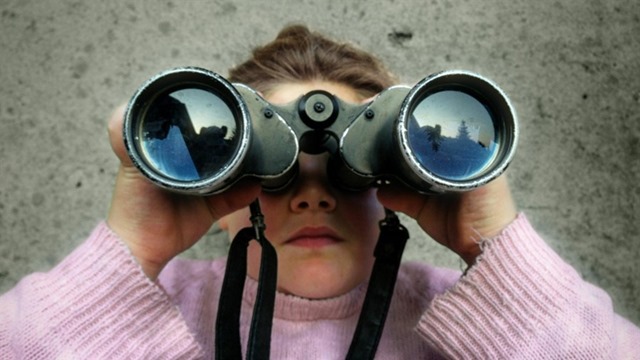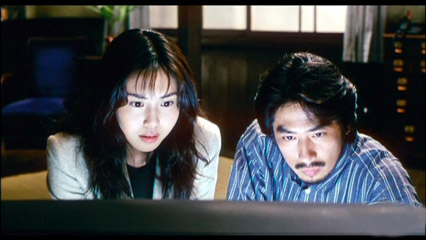Written by Katherine Murray.
The Girl Down Loch Änzi, which had its North American premiere at the 2017 Hot Docs film festival, is a ghost story. The film’s central character, Laura, lives on a Swiss farm that borders the fabled Änziloch – a deep ravine that, legend has it, is home to the ghost of a woman cast out from the village several centuries before, and either left to die or imprisoned below. As the film goes on though, there is a gathering sense that its real subject is the women who disappear, or leave, or are cast out in general for reasons that can’t be spoken.
Most of the film’s action focuses on a summer that Laura spends on the farm and one week in particular that she spends with a village boy, Thom. Their conversation often turns to the ghost of the Änziloch; they speculate about what this woman did to deserve being trapped in the ravine. In the version of the legend Laura is familiar with, the woman got into a fight with her father and accidentally killed him, at which point she either jumped, or was thrown by a storm or by God, into the ravine. Some of the neighbors speculate that the woman was pregnant as well but, as Laura says, everyone has their own version of the story, and it’s hard to say what is the truth.
The farm itself is a site of conflicting narratives, some of which are unsettling. The buildings have fallen into disrepair and the animals live in what used to be Laura’s family home, meaning that, when she takes Thom on a tour, they walk down a hallway and open what looks like a bedroom door to a room full of birds who are viciously trying to mate with each other. The flapping and screeching that follows is either funny or disquieting or, maybe more accurately, both. Similarly, there’s a very long sequence near the start of the film – gruesome enough that Hot Docs posted a warning for incoming viewers – where one of the rabbits that lives on the farm, whom Laura was petting a few minutes before, is killed and butchered in front of her. Her request to keep the rabbit’s fur begins a very conflicted subplot about the small pleasures she’s able to find and protect for herself.
That’s not to say that Laura seems unhappy on the farm – just that the overall depiction of farm-life isn’t especially light-hearted. There is a darkness to the lens writer/director Alice Schmid turns on this story that often hovers around the edges, unspoken and just out of sight.
The same oblique sense of darkness came out in the Q&A after the screening I attended, in which Schmid explained that another character in the film, an elderly nun who was rumored to have gone into the Änziloch before joining the convent, wouldn’t say on camera why she’d left. In a similar vein, Schmid, who left Switzerland as a young woman and didn’t return until she was an accomplished filmmaker in her 60s, described her homecoming by saying, “I was surprised. Everyone was glad to see me. No one asked why I left. You don’t talk about these things.”
There is a persistent sense in The Girl Down Loch Änzi that the ghost of the Änziloch is made of these very same things.
The other interesting tension in the film, which also came up during the Q&A, is its complex relationship with factuality. Every documentary has to make some kind of peace with the idea that it isn’t possible to show the world exactly as it is. By filming a thing, by observing it, by cutting the footage together to tell a story, you’re always imposing a perspective on the events and, usually, you influence what happens. The filmmakers working on The Girl Down Loch Änzi influenced events a lot.
One of the most important details is that Thom, the boy who comes to work on the farm for a week, has come mostly in response to a casting call. As Schmid – who readily and openly describes the film as partly fiction – explained during the Q&A, she was looking for a character who could serve as a surrogate for the audience, as an outsider, and also offer up a worldview that was different from Laura’s, so that Laura would have someone interesting to talk to. Although there’s nothing necessarily wrong with that approach, it’s worth noting that the film, by itself, makes it appear that Thom is there just by coincidence. It also develops a narrative that’s slightly unflattering to Thom, in which he and Laura have a budding romance that he then abandons. It’s hard to know whether he or Laura would have been interested in each other at all if they weren’t making a movie.
Similarly, it’s hard to know whether Laura’s parents would have let her trek into the Änziloch alone – which she eventually does – if she hadn’t had a film crew watching over her.
The Girl Down Loch Änzi is an unusually stylish documentary, with beautifully-composed shots and scenes that play out with a feature film’s attention to blocking and, as soon as you start to reverse-engineer how it was made, you realize that it involves a lot of staging. That’s not good or bad, but it does mean that, on the spectrum between objective observation and straight-up fiction that all documentaries occupy, the film occupies a space close to reality TV shows. It’s not fake, and there’s certainly some element of truth that gives us insight into human behavior – but it’s also not a reflection of how the characters would have behaved if there wasn’t a camera crew following them.
It might be best to view the film as a collaboration between Schmid and Laura – who became friends after filming a previous documentary together – in which they craft a story that’s meaningful to both of them, but isn’t what literally happened. Kind of like the legend of the ghost.
Katherine Murray is a Toronto-based writer who yells about movies, TV and video games on her blog.







